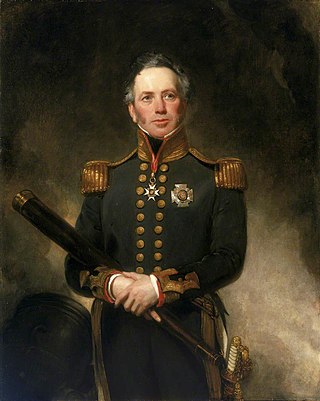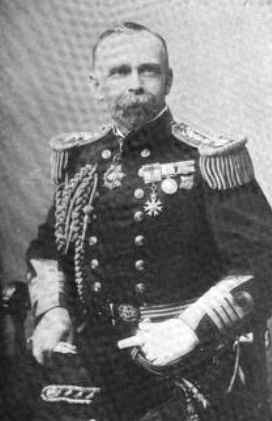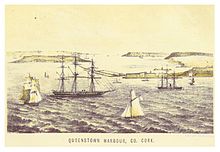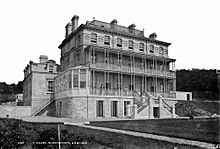
The Second Sea Lord and Deputy Chief of Naval Staff is deputy to the First Sea Lord and the second highest-ranking officer to currently serve in the Royal Navy and is responsible for personnel and naval shore establishments. Originally titled Second Naval Lord in 1830, the post was restyled Second Sea Lord in 1904. They are based at Navy Command, Headquarters.

Cobh, known from 1849 until 1920 as Queenstown, is a seaport town on the south coast of County Cork, Ireland. With a population of 14,418 inhabitants at the 2022 census, Cobh is on the south side of Great Island in Cork Harbour and home to Ireland's only dedicated cruise terminal. Tourism in the area draws on the maritime and emigration legacy of the town.

The Home Fleet was a fleet of the Royal Navy that operated from the United Kingdom's territorial waters from 1902 with intervals until 1967. In 1967, it was merged with the Mediterranean Fleet creating the new Western Fleet.

Cork Harbour is a natural harbour and river estuary at the mouth of the River Lee in County Cork, Ireland. It is one of several which lay claim to the title of "second largest natural harbour in the world by navigational area". Other contenders include Halifax Harbour in Canada, Trincomalee Harbour in Sri Lanka and Poole Harbour in England.

The Channel Fleet and originally known as the Channel Squadron was the Royal Navy formation of warships that defended the waters of the English Channel from 1854 to 1909 and 1914 to 1915.

Vice Admiral Sir Edward Brace was a senior officer of the British Royal Navy during the French Revolutionary and Napoleonic Wars. Most of his career was spent as a successful independent captain, and he was three times involved in successful actions against French or Dutch frigates, resulting in rapid promotion. After the end of the Napoleonic Wars, Brace commanded the first rate HMS Impregnable at the Bombardment of Algiers in 1816, but made a serious mistake in his navigation and exposed his ship to the port's defences unnecessarily. As a result, he suffered 210 casualties and his career suffered as a result. Despite this setback, he continued to rise during the 1820s and gradually became an admiral and a knight. In the 1830s he was made commander in chief at the Nore and died on station in 1843.
Vice-Admiral Sir Maurice Swynfen Fitzmaurice, was an officer of the Royal Navy.

The Commander-in-Chief, Portsmouth, was a senior commander of the Royal Navy for hundreds of years. The commanders-in-chief were based at premises in High Street, Portsmouth from the 1790s until the end of Sir Thomas Williams's tenure, his successor, Sir Philip Durham, being the first to move into Admiralty House at the Royal Navy Dockyard, where subsequent holders of the office were based until 1969. Prior to World War I the officer holder was sometimes referred to in official dispatches as the Commander-in-Chief, Spithead.
Admiral Sir George Lambart Atkinson-Willes was a Royal Navy officer who went on to be Commander-in-Chief, East Indies Station.

Admiral Andrew Kennedy Bickford CMG was a Royal Navy officer who went on to be Commander-in-Chief, Pacific Station.

Admiral Sir Lewis Bayly, was a Royal Navy officer who served during the First World War.

The Reserve Fleet was a Royal Navy formation of decommissioned vessels which could be brought to a state of readiness at time of war.

Admiral Sir Reginald Godfrey Otway Tupper, was a Royal Navy officer active during the late Victorian period and the First World War.

Commodore Submarine Service is a post in the Royal Navy which involves command of the Royal Navy Submarine Service. It evolved from the post of Inspecting Captain of Submarines in 1901 and would later evolve to become the post of Flag Officer Submarines in 1944.
Vice Admiral Donald Hugh Mackay was a Royal Navy officer who became Commander-in-Chief, Queenstown.

Cove Fort is a small bastioned land battery to the east of Cobh in County Cork, Ireland. Built as a coastal defence fortification in 1743, on instruction of the then Vice-Admiral of the Coast, it replaced a number of temporary coastal artillery batteries which defended Cork Harbour.
The Downs Station also known as the Commander-in-Chief, the Downs or Admiral Commanding at the Downs was a formation of the Kingdom of Great Britain and then the United Kingdom's Royal Navy based at Deal. It was a major command of the Royal Navy from 1626 until 1834.

The Admiral Commanding, Reserves, was a senior Royal Navy post that existed from 1875 to 1976.
The Commander-in-Chief, Leith formally known as the Commander-in-Chief at Leith and on the Coast of Scotland was a military commander and formation of the Royal Navy from 1745 to 1825.













